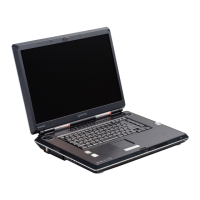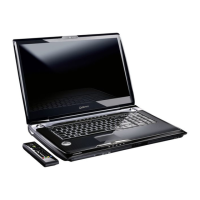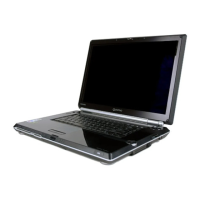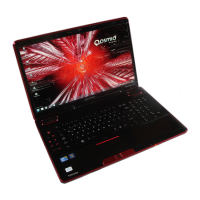Glossary-10 User’s Manual
Qosmio F60 Series
M
main board: See motherboard.
megabyte (MB): A unit of data storage equal to 1024 kilobytes.
See also kilobyte.
megahertz: A unit of wave frequency that equals 1 million cycles per
second. See also hertz.
memory: Typically refers to the computer’s main memory, where programs
are run and data is temporarily stored and processed. Memory can
be volatile and hold data temporarily, such as RAM, or it can be
nonvolatile and hold data permanently, such as ROM. A computer’s
main memory is RAM. See RAM, ROM.
menu: A software interface that displays a list of options on the screen.
Also called a screen.
microprocessor: A hardware component contained in a single integrated
circuit that carries out instructions. Also called the central
processing unit (CPU), one of the main parts of the computer.
mode: A method of operation, for example, the Shut Down Mode, Sleep
Mode or the Hibernation Mode.
modem: Derived from modulator/demodulator, a device that converts
(modulates) digital data for transmission over telephone lines and
then converts modulated data (demodulates) to digital format where
received.
monitor: A device that uses rows and columns of pixels to display
alphanumeric characters or graphic images. See also CRT.
motherboard: A name sometimes used to refer to the main printed circuit
board in processing equipment. It usually contains integrated
circuits that perform the processor’s basic functions and provides
connectors for adding other boards that perform special functions.
MP3: An audio compression standard that enables high-quality
transmission and real-time playback of sound files.
N
network: A collection of computers and associated devices that are
connected by communications facilities. A network allows you to
share data and peripheral devices, such as printers, with other
users and to exchange electronic mail.
non-system disk: A disk for storing programs and data that cannot be
used to start the computer. Compare system disk.
nonvolatile memory: Memory, usually read-only (ROM), that is capable of
permanently storing information. Turning the computer’s power off
does not alter data stored in nonvolatile memory.
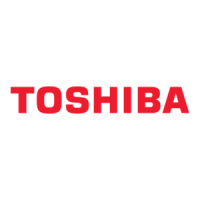
